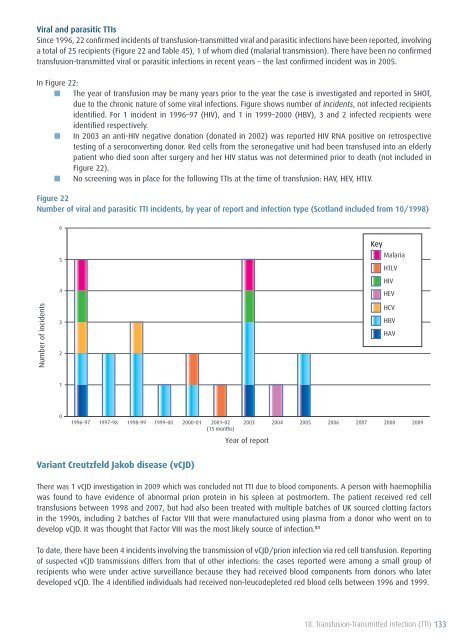SHOT Annual Report 2009 - Serious Hazards of Transfusion
SHOT Annual Report 2009 - Serious Hazards of Transfusion
SHOT Annual Report 2009 - Serious Hazards of Transfusion
Create successful ePaper yourself
Turn your PDF publications into a flip-book with our unique Google optimized e-Paper software.
Viral and parasitic TTIs<br />
Since 1996, 22 confirmed incidents <strong>of</strong> transfusion-transmitted viral and parasitic infections have been reported, involving<br />
a total <strong>of</strong> 25 recipients (Figure 22 and Table 45), 1 <strong>of</strong> whom died (malarial transmission). There have been no confirmed<br />
transfusion-transmitted viral or parasitic infections in recent years – the last confirmed incident was in 2005.<br />
In Figure 22:<br />
■■ The year <strong>of</strong> transfusion may be many years prior to the year the case is investigated and reported in <strong>SHOT</strong>,<br />
due to the chronic nature <strong>of</strong> some viral infections. Figure shows number <strong>of</strong> incidents, not infected recipients<br />
identified. For 1 incident in 1996–97 (HIV), and 1 in 1999–2000 (HBV), 3 and 2 infected recipients were<br />
identified respectively.<br />
■■ In 2003 an anti-HIV negative donation (donated in 2002) was reported HIV RNA positive on retrospective<br />
testing <strong>of</strong> a seroconverting donor. Red cells from the seronegative unit had been transfused into an elderly<br />
patient who died soon after surgery and her HIV status was not determined prior to death (not included in<br />
Figure 22).<br />
■■ No screening was in place for the following TTIs at the time <strong>of</strong> transfusion: HAV, HEV, HTLV.<br />
Figure 22<br />
Number <strong>of</strong> viral and parasitic TTI incidents, by year <strong>of</strong> report and infection type (Scotland included from 10/1998)<br />
6<br />
Number <strong>of</strong> incidents<br />
5<br />
4<br />
3<br />
2<br />
Key<br />
Malaria<br />
HTLV<br />
HIV<br />
HEV<br />
HCV<br />
HBV<br />
HAV<br />
1<br />
0<br />
1996–97<br />
1997–98<br />
1998–99<br />
1999–00<br />
2000–01<br />
2001–02<br />
(15 months)<br />
2003<br />
2004<br />
2005<br />
2006<br />
2007 2008 <strong>2009</strong><br />
Year <strong>of</strong> report<br />
Variant Creutzfeld Jakob disease (vCJD)<br />
There was 1 vCJD investigation in <strong>2009</strong> which was concluded not TTI due to blood components. A person with haemophilia<br />
was found to have evidence <strong>of</strong> abnormal prion protein in his spleen at postmortem. The patient received red cell<br />
transfusions between 1998 and 2007, but had also been treated with multiple batches <strong>of</strong> UK sourced clotting factors<br />
in the 1990s, including 2 batches <strong>of</strong> Factor VIII that were manufactured using plasma from a donor who went on to<br />
develop vCJD. It was thought that Factor VIII was the most likely source <strong>of</strong> infection. 51<br />
To date, there have been 4 incidents involving the transmission <strong>of</strong> vCJD/prion infection via red cell transfusion. <strong>Report</strong>ing<br />
<strong>of</strong> suspected vCJD transmissions differs from that <strong>of</strong> other infections: the cases reported were among a small group <strong>of</strong><br />
recipients who were under active surveillance because they had received blood components from donors who later<br />
developed vCJD. The 4 identified individuals had received non-leucodepleted red blood cells between 1996 and 1999.<br />
18. <strong>Transfusion</strong>-Transmitted Infection (TTI) 133












